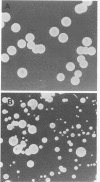Abstract
Inconsistencies in the results of disk diffusion tests of oxacillin against Staphylococcus aureus that occurred when using commercially prepared Mueller-Hinton agar from different sources led us to evaluate the ability of media from different sources to detect resistance to oxacillin, methicillin, and nafcillin in S. aureus. Mueller-Hinton agar from five manufacturers was prepared in our laboratory and used for standard disk diffusion and agar dilution tests. Ten oxacillin-resistant S. aureus isolates, of which three were definitive-resistant and seven were occult-resistant, were examined. All definitive-resistant strains were resistant to all three antimicrobial agents on four out of five agars. The occult-resistant strains were consistently detected as resistant on only one of the agars. With only slight differences, oxacillin, methicillin, and nafcillin resistance was more readily detected by disk diffusion and agar dilution when initially incubated at 30 degrees C, and extended incubation improved the detection. The frequency of resistance within a population of occult-resistant cells was low compared with the frequency within a population of definitively resistant cells. The heterogeneity of colony morphology and apparent growth rates within a population of occult-resistant cells contributed to the problem of detecting some resistant isolates. Definitive-resistant isolates were characterized by a very high and stable frequency of resistance. Occult-resistant strains were characterized by a lower frequency of resistance, although the true frequency of resistance may be difficult to ascertain because of heterogeneity in growth rates.
Full text
PDF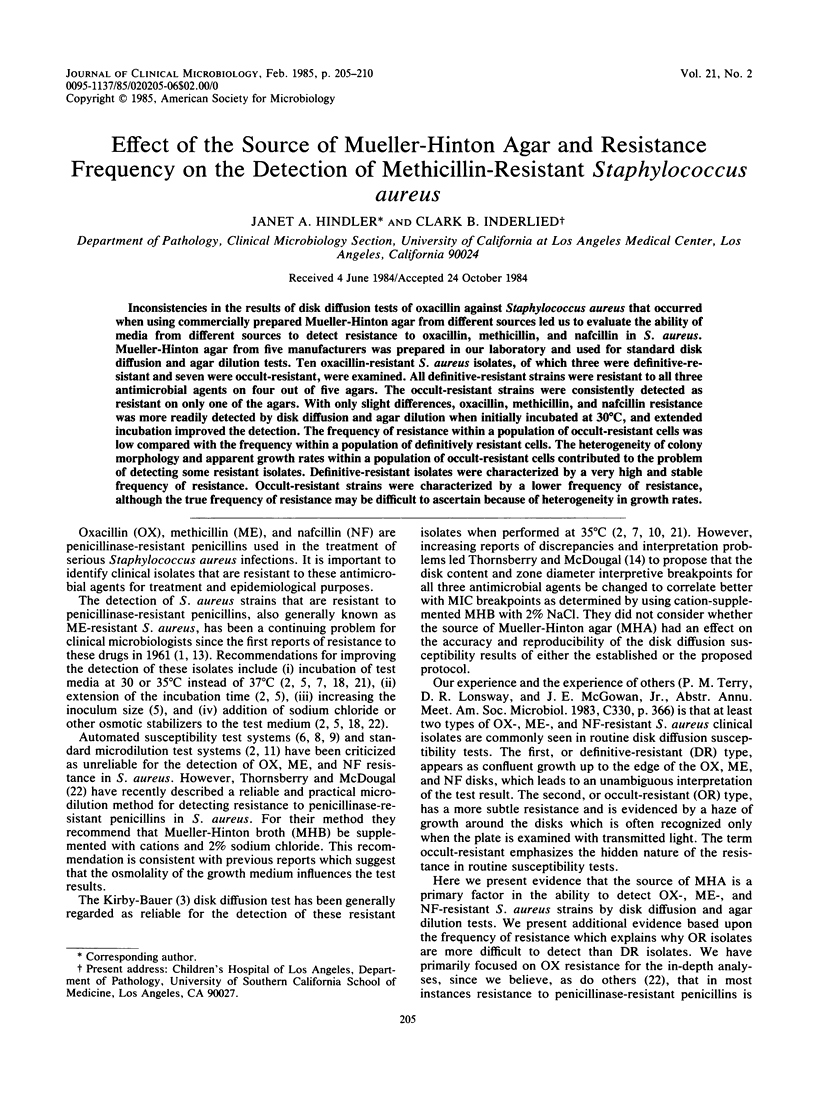

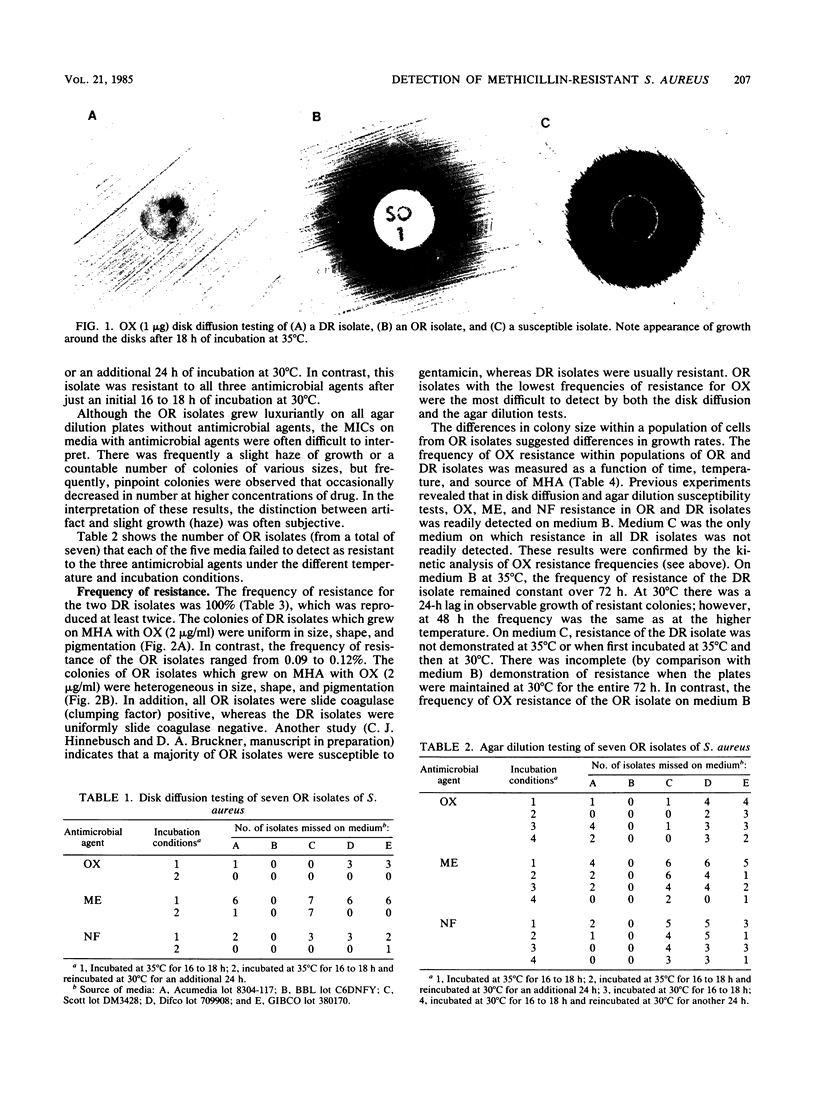
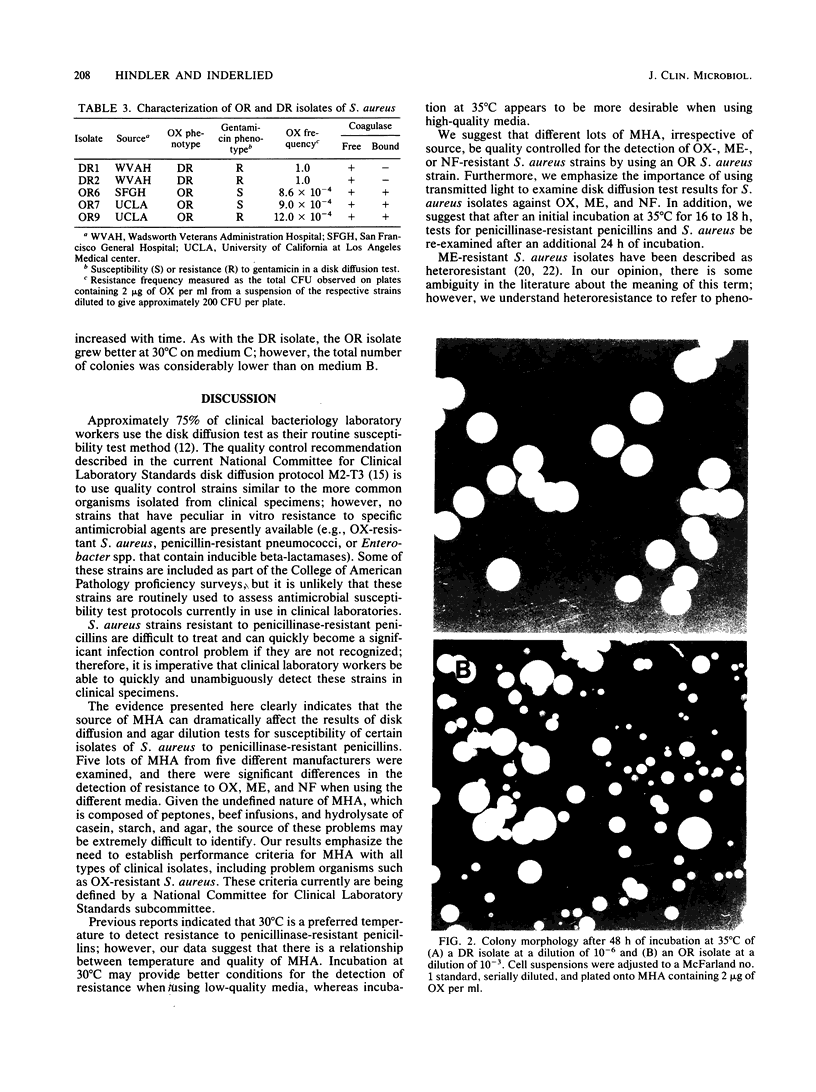
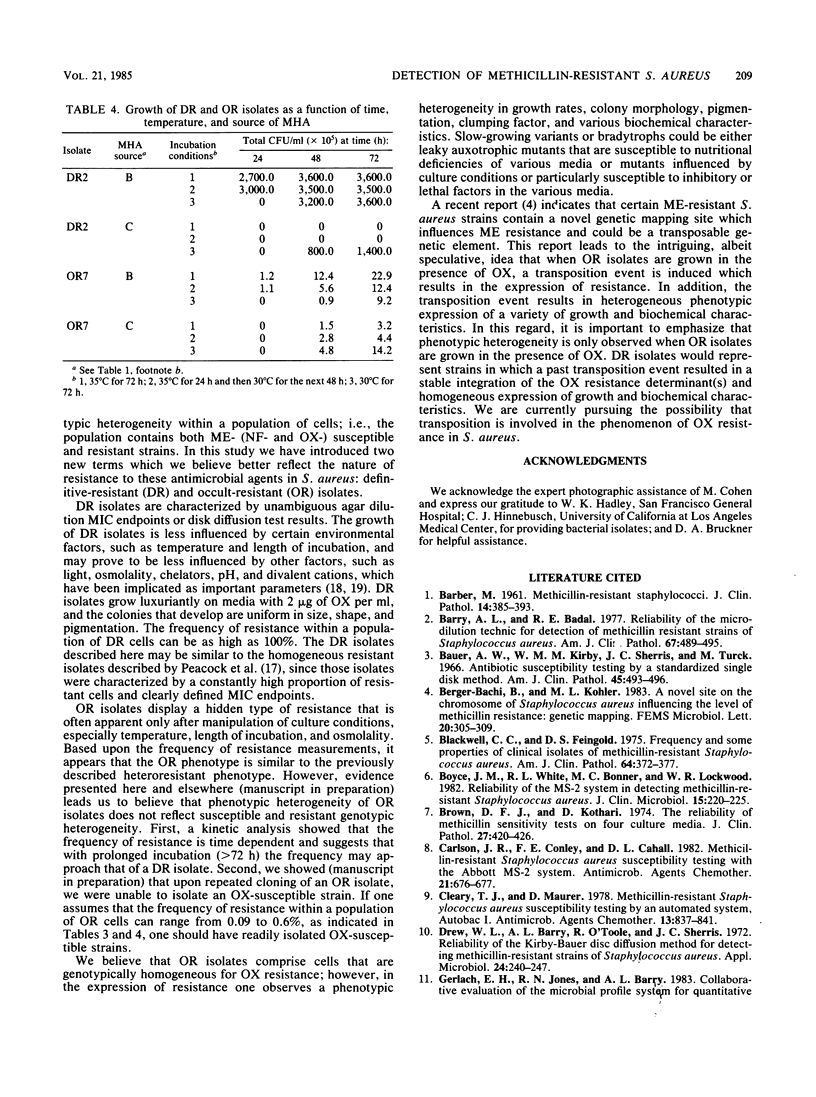
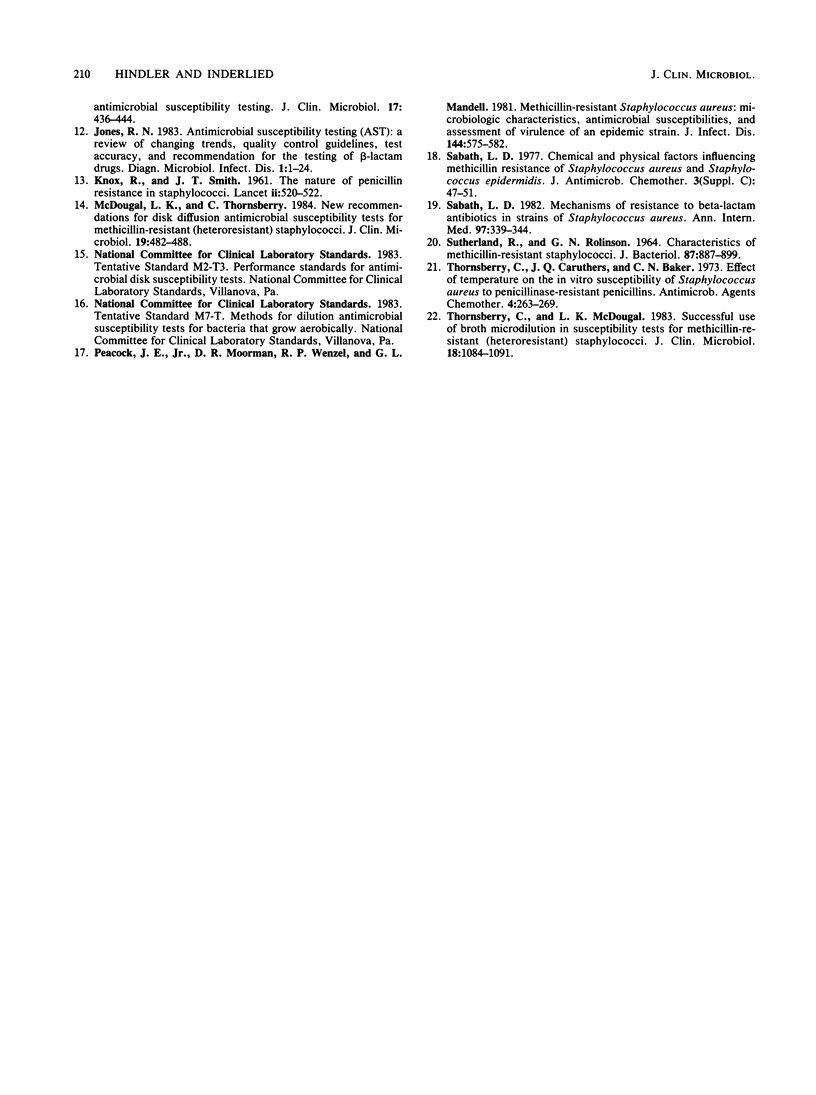
Images in this article
Selected References
These references are in PubMed. This may not be the complete list of references from this article.
- BARBER M. Methicillin-resistant staphylococci. J Clin Pathol. 1961 Jul;14:385–393. doi: 10.1136/jcp.14.4.385. [DOI] [PMC free article] [PubMed] [Google Scholar]
- Barry A. L., Badal R. E. Reliability of the microdilution technic for detection of methicillin-resistant strains of staphylococcus aureus. Am J Clin Pathol. 1977 May;67(5):489–495. doi: 10.1093/ajcp/67.5.489. [DOI] [PubMed] [Google Scholar]
- Bauer A. W., Kirby W. M., Sherris J. C., Turck M. Antibiotic susceptibility testing by a standardized single disk method. Am J Clin Pathol. 1966 Apr;45(4):493–496. [PubMed] [Google Scholar]
- Blackwell C. C., Feingold D. S. Frequency and some properties of clinical isolates of methicillin-resistant Staphylococcus aureus. Am J Clin Pathol. 1975 Sep;64(3):372–377. doi: 10.1093/ajcp/64.3.372. [DOI] [PubMed] [Google Scholar]
- Boyce J. M., White R. L., Bonner M. C., Lockwood W. R. Reliability of the MS-2 system in detecting methicillin-resistant Staphylococcus aureus. J Clin Microbiol. 1982 Feb;15(2):220–225. doi: 10.1128/jcm.15.2.220-225.1982. [DOI] [PMC free article] [PubMed] [Google Scholar]
- Brown D. F., Kothari D. The reliability of methicillin sensitivity tests on four culture media. J Clin Pathol. 1974 May;27(5):420–426. doi: 10.1136/jcp.27.5.420. [DOI] [PMC free article] [PubMed] [Google Scholar]
- Carlson J. R., Conley F. E., Cahall D. L. Methicillin-resistant Staphylococcus aureus susceptibility testing with Abbott MS-2 system. Antimicrob Agents Chemother. 1982 Apr;21(4):676–677. doi: 10.1128/aac.21.4.676. [DOI] [PMC free article] [PubMed] [Google Scholar]
- Cleary T. J., Maurer D. Methicillin-resistant Staphylococcus aureus susceptibility testing by an automated system, Autobac I. Antimicrob Agents Chemother. 1978 May;13(5):837–841. doi: 10.1128/aac.13.5.837. [DOI] [PMC free article] [PubMed] [Google Scholar]
- Drew W. L., Barry A. L., O'Toole R., Sherris J. C. Reliability of the Kirby-Bauer disc diffusion method for detecting methicillin-resistant strains of Staphylococcus aureus. Appl Microbiol. 1972 Aug;24(2):240–247. doi: 10.1128/am.24.2.240-247.1972. [DOI] [PMC free article] [PubMed] [Google Scholar]
- Gerlach E. H., Jones R. N., Barry A. L. Collaborative evaluation of the microbial profile system for quantitative antimicrobial susceptibility testing. J Clin Microbiol. 1983 Mar;17(3):436–444. doi: 10.1128/jcm.17.3.436-444.1983. [DOI] [PMC free article] [PubMed] [Google Scholar]
- Jones R. N. Antimicrobial susceptibility testing (AST): a review of changing trends, quality control guidelines, test accuracy, and recommendation for the testing of beta-lactam drugs. Diagn Microbiol Infect Dis. 1983 Mar;1(1):1–24. doi: 10.1016/0732-8893(83)90028-7. [DOI] [PubMed] [Google Scholar]
- KNOX R., SMITH J. T. The nature of penicillin resistance in staphylococci. Lancet. 1961 Sep 2;2(7201):520–522. doi: 10.1016/s0140-6736(61)92958-0. [DOI] [PubMed] [Google Scholar]
- McDougal L. K., Thornsberry C. New recommendations for disk diffusion antimicrobial susceptibility tests for methicillin-resistant (heteroresistant) staphylococci. J Clin Microbiol. 1984 Apr;19(4):482–488. doi: 10.1128/jcm.19.4.482-488.1984. [DOI] [PMC free article] [PubMed] [Google Scholar]
- Peacock J. E., Jr, Moorman D. R., Wenzel R. P., Mandell G. L. Methicillin-resistant Staphylococcus aureus: microbiologic characteristics, antimicrobial susceptibilities, and assessment of virulence of an epidemic strain. J Infect Dis. 1981 Dec;144(6):575–582. doi: 10.1093/infdis/144.6.575. [DOI] [PubMed] [Google Scholar]
- SUTHERLAND R., ROLINSON G. N. CHARACTERISTICS OF METHICILLIN-RESISTANT STAPHYLOCOCCI. J Bacteriol. 1964 Apr;87:887–899. doi: 10.1128/jb.87.4.887-899.1964. [DOI] [PMC free article] [PubMed] [Google Scholar]
- Sabath L. D. Chemical and physical factors influencing methicillin resistance of Staphylococcus aureus and Staphylococcus epidermidis. J Antimicrob Chemother. 1977 Nov;3 (Suppl 100):47–51. doi: 10.1093/jac/3.suppl_c.47. [DOI] [PubMed] [Google Scholar]
- Sabath L. D. Mechanisms of resistance to beta-lactam antibiotics in strains of Staphylococcus aureus. Ann Intern Med. 1982 Sep;97(3):339–344. doi: 10.7326/0003-4819-97-3-339. [DOI] [PubMed] [Google Scholar]
- Thornsberry C., Caruthers J. Q., Baker C. N. Effect of temperature on the in vitro susceptibility of Staphylococcus aureus to penicillinase-resistant penicillins. Antimicrob Agents Chemother. 1973 Sep;4(3):263–269. doi: 10.1128/aac.4.3.263. [DOI] [PMC free article] [PubMed] [Google Scholar]
- Thornsberry C., McDougal L. K. Successful use of broth microdilution in susceptibility tests for methicillin-resistant (heteroresistant) staphylococci. J Clin Microbiol. 1983 Nov;18(5):1084–1091. doi: 10.1128/jcm.18.5.1084-1091.1983. [DOI] [PMC free article] [PubMed] [Google Scholar]




